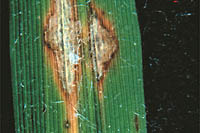By David O. Tebeest,
Plant Pathology Department, University of Arkansas
One recent survey of the United States reported that the number one hobby was gardening. However, many children have never had the opportunity to plant a seed or pick a tomato fresh from the vine. Thanks to a few educators, students are now getting the chance to plant a seed, pull a weed, etc. Recently a workshop entitled "School Gardens: Nourishing Bodies, Expanding Minds" was sponsored by the Youth Programs Committee at the 2001 American Phytopathological Society Annual Meeting in Salt Lake City, Utah. The workshop was offered to area teachers interested in a gardening program in their own schools.


The setting for the workshop was the Thanksgiving Point Institute, a beautiful education garden located outside of Salt Lake City. Jim Flint (National Gardening Association) spoke to teachers and APS members about existing youth garden programs around the U. S. Mr. Flint shared stories and a slide show of the gardens.

Following Mr. Flint, Dr. Richard Raid (University of Florida, Everglades Research and Education Center) spoke to the group about how to organize a school garden. He covered topics such as funding, community volunteers, and extracurricular activities centered around the garden. Dr. Raid spoke about the existing program "Students Sharing Our Agricultural Roots" (SOAR), operating in over 25 elementary and middle schools in Palm Beach County, FL.
Many people question whether gardens are an effective teaching too. Many of those who have used school gardens to teach anything from math, science, to history will tell you that they most definitely are. Dr. Monika E. Reuter (University of Florida, Everglades Research and Education Center) presented information from a study of the gardening program in Florida. Through interviews with teachers of the program and also observations of the program, she has been able to confirm others' findings that the gardens are a wondrous thing for children. Also noted was that school gardens enticed children to eat a more nutritious diet as the students were more likely to eat a vegetable they had grown than to eat the same vegetable purchased at the market.
Debra Spielmaker (Utah State University, Utah Agriculture in the Classroom) spoke about kits and project ideas available to Utah educators. She also provided information regarding curriculum and newsletters.
Workshop attendees and presenters were treated to a lunch and a tour of the Thanksgiving Point Gardens.
 |
Views: Rice blast
Blast is one of the most important diseases of rice worldwide, and it occurs in nearly every region in which rice is grown. Blast is more severe in temperate regions of the world, at higher elevations in the tropics, and in the upland areas where rice is rainfed (not grown in paddies). Click image for an larger view, more information |
